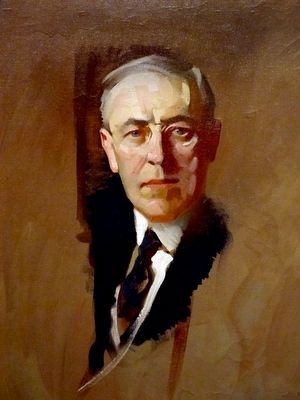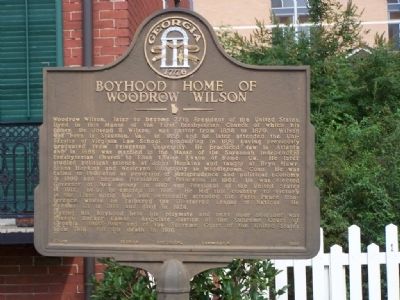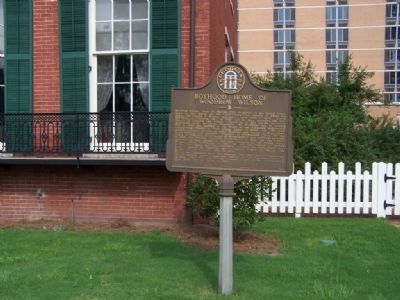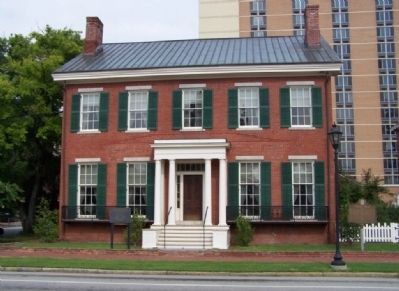Augusta in Richmond County, Georgia — The American South (South Atlantic)
Boyhood Home of Woodrow Wilson
During his boyhood here his playmate and next door neighbor was Joseph Rucker Lamar, Associate Justice of the Supreme Court of Georgia, 1902-1905 and of the Supreme Court of the United States from 1910, till his death in 1916.
Erected 1955 by Georgia Historical Commission. (Marker Number 121-18.)
Topics and series. This historical marker is listed in these topic lists: Education • Government & Politics. In addition, it is included in the Former U.S. Presidents: #28 Woodrow Wilson, and the Georgia Historical Society series lists. A significant historical year for this entry is 1858.
Location. 33° 28.299′ N, 81° 57.896′ W. Marker is in Augusta, Georgia, in Richmond County. Marker is on 7th Street near Telfair Street, on the right when traveling south. Touch for map. Marker is at or near this postal address: 419 7th St, Augusta GA 30901, United States of America. Touch for directions.
Other nearby markers. At least 8 other markers are within walking distance of this marker. Joseph R. Lamar, Associate Justice (within shouting distance of this marker); The First Presbyterian Church (about 300 feet away, measured in a direct line); a different marker also named The First Presbyterian Church (about 300 feet away); Emily Tubman Monument (about 400 feet away); First Christian Church (about 500 feet away); Paul Fitzsimmons Eve (about 500 feet away); Church Of The Most Holy Trinity (about 500 feet away); Two Early Augusta Churches (about 500 feet away). Touch for a list and map of all markers in Augusta.
Related marker. Click here for another marker that is related to this marker. Boyhood Home in Columbia, SC
Also see . . .
1. Boyhood Home of Woodrow Wilson. The 28th President of the United States spent his boyhood years in this home. (Submitted on January 21, 2013, by Mike Stroud of Bluffton, South Carolina.)
2. President Gets the Spanish Flu!. 4:18 minute YouTube video. (Submitted on May 12, 2020.)

Photographed By Allen C. Browne, February 16, 2015
4. Woodrow Wilson
This c. 1919 painting of Woodrow Wilson by John Christen Johansen hangs in the National Portrait Gallery in Washington, DC.
“Elected to the White House after winning wide acclaim as the reforming governor of New Jersey, Woodrow Wilson left an impressive legacy of change that sought to curb abusive business practices and improve conditions for workers. But Wilson was not as successful in winning approval for his international idealism during World War I. Determined to make this conflict ‘the war to end all wars,’ he sought at its end to create a world order that put peace ahead of national self-interest. America's European allies, however, undermined these hopes, insisting on a postwar peace settlement that contained the seeds of another war. A far worse disappointment for Wilson himself was his failure to persuade his own country to join the League of Nations, an organization he had conceived as the best hope for avoiding future wars. Having suffered a stroke while campaigning for American entry into the league, he left office in 1921, broken in both health and spirit.”
“Elected to the White House after winning wide acclaim as the reforming governor of New Jersey, Woodrow Wilson left an impressive legacy of change that sought to curb abusive business practices and improve conditions for workers. But Wilson was not as successful in winning approval for his international idealism during World War I. Determined to make this conflict ‘the war to end all wars,’ he sought at its end to create a world order that put peace ahead of national self-interest. America's European allies, however, undermined these hopes, insisting on a postwar peace settlement that contained the seeds of another war. A far worse disappointment for Wilson himself was his failure to persuade his own country to join the League of Nations, an organization he had conceived as the best hope for avoiding future wars. Having suffered a stroke while campaigning for American entry into the league, he left office in 1921, broken in both health and spirit.”
Credits. This page was last revised on May 12, 2020. It was originally submitted on August 3, 2008, by Mike Stroud of Bluffton, South Carolina. This page has been viewed 1,519 times since then and 30 times this year. Photos: 1, 2, 3. submitted on August 3, 2008, by Mike Stroud of Bluffton, South Carolina. 4. submitted on October 1, 2015, by Allen C. Browne of Silver Spring, Maryland. • Kevin W. was the editor who published this page.


